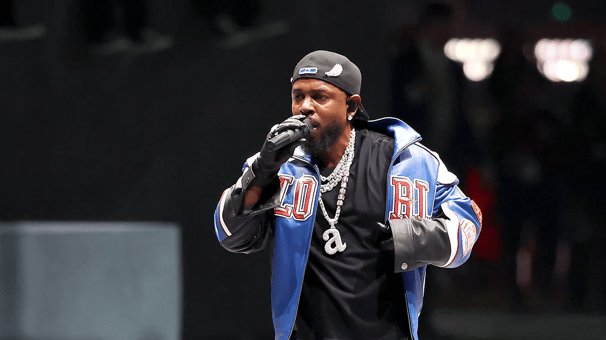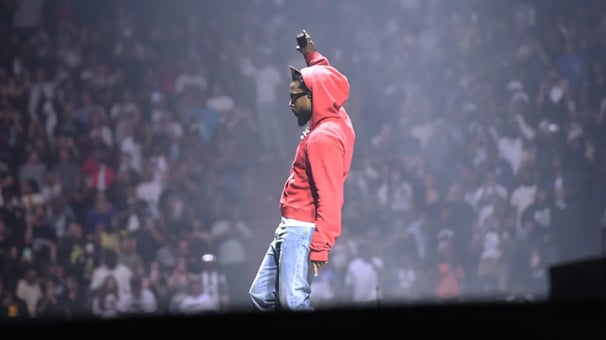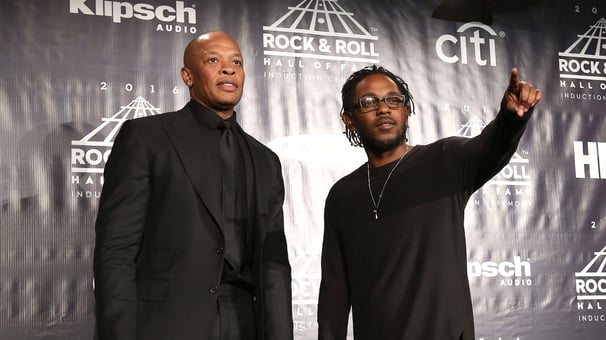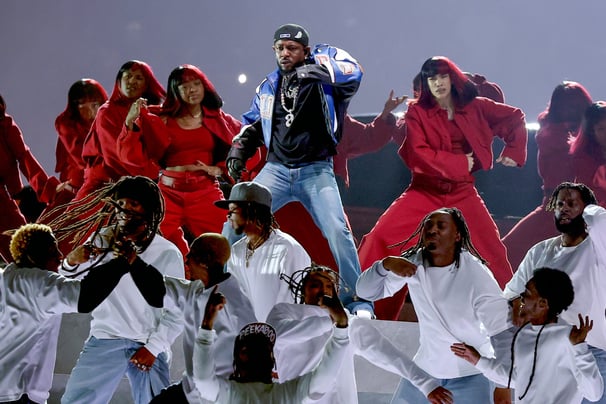From Compton’s Streets to Global Stages
In the heart of Compton, California, a city synonymous with hip hop’s rawest tales, Kendrick Lamar Duckworth was born on June 17, 1987, destined to become one of the genre’s greatest voices. Known as the Pulitzer Prize-winning poet of rap, Kendrick’s journey from a shy kid dodging gang life to a global icon is a testament to hip hop’s power to transform. For fans vibing to “Not Like Us,” producers studying his layered beats, or MCs chasing his lyrical depth, Kendrick’s life, career, and discography are a masterclass in artistry and resilience. In 2025, fresh off a record-breaking Super Bowl LIX halftime show, Kendrick stands as hip hop’s beating heart. Let’s trace the path of this Compton king, from his roots to his revolutionary records.
Early Life: Surviving Compton’s Chaos
Kendrick grew up in a Compton scarred by poverty and violence, where his parents, Kenneth Duckworth and Paula Oliver, had fled Chicago’s South Side to escape gang ties. Named after Temptations singer Eddie Kendricks, young Kendrick lived in Section 8 housing, relying on welfare. His childhood was a paradox: “good memories” of sneaking into parents’ house parties to hear Rakim and Ice Cube clashed with trauma—witnessing his first murder at age five outside his apartment. By eight, seeing Tupac Shakur and Dr. Dre film “California Love” in Compton ignited his musical spark.
A shy, observant kid, Kendrick was nicknamed “Man-Man” for his mature demeanor. His family faced homelessness, and Kendrick skirted gang culture, despite ties to the Westside Pirus. A gang war during tenth-grade summer school pulled him into Compton’s hedonistic underbelly, leading to police run-ins and health scares. His father’s intervention and a friend’s death at 16 led Kendrick to Christianity, a cornerstone of his art. Graduating as a straight-A student from Centennial High School in 2005, he briefly eyed psychology or astronomy but chose music, freestyling as K.Dot and catching the eye of future collaborator Dave Free.
Kendrick Lamar: The Life, Career, and Discography of Hip Hop’s Poetic King in 2025




Career Beginnings: K.Dot to Kendrick Lamar
Kendrick’s career kicked off under the stage name K.Dot, dropping his first mixtape, Youngest Head Nigga in Charge (2003), at 16. Its buzz landed him a deal with Top Dawg Entertainment (TDE) in 2005. Mixtapes like Training Day (2005), No Sleep ‘Til NYC (2007, with Jay Rock), and C4 (2009, inspired by Lil Wayne’s Tha Carter III) honed his craft. In 2009, he ditched K.Dot for his birth name, releasing The Kendrick Lamar EP and forming Black Hippy with TDE’s Jay Rock, Ab-Soul, and ScHoolboy Q. His 2010 mixtape Overly Dedicated hit No. 72 on Billboard’s Top R&B/Hip-Hop Albums, signaling his rise.
The 2011 debut album Section.80, released digitally, was a game-changer. Tracks like “Rigamortus” showcased his lyrical dexterity, tackling addiction and street life with a poet’s eye. Its online success led to a joint deal with Dr. Dre’s Aftermath Entertainment and Interscope Records, cementing Kendrick as a force.
Breakthrough and Stardom: Good Kid, M.A.A.D City to DAMN.
Kendrick’s 2012 major-label debut, Good Kid, M.A.A.D City, is a cinematic masterpiece, often called the greatest concept album ever by Rolling Stone. Chronicling a day in Compton’s gang-ridden streets, it blends gangsta rap with storytelling. Hits like “Swimming Pools (Drank),” “Poetic Justice” (with Drake), and “Bitch, Don’t Kill My Vibe” charted globally, with the album becoming the longest-charting hip hop studio album on the Billboard 200. Its raw empathy—tracks like “Sing About Me, I’m Dying of Thirst” mourn lost lives—earned universal acclaim.
To Pimp a Butterfly (2015) pushed boundaries, fusing jazz, funk, and spoken word to confront Black identity and systemic racism. Singles like “Alright,” an anthem for the Black Lives Matter movement, “King Kunta,” and “i” (a self-love hymn) charted high, with the album hitting No. 1 in the U.S. and UK. Critics hailed its complexity, and it won five Grammys. The surprise 2016 release untitled unmastered., a collection of outtakes, further showcased his fearless creativity.
DAMN. (2017) was Kendrick’s commercial peak, debuting at No. 1 and earning the 2018 Pulitzer Prize for Music—the first for a non-classical/jazz artist. With bangers like “HUMBLE.” (his first U.S. No. 1 as a lead artist) and “DNA.,” it tackled faith, doubt, and fame. Every track went gold or higher, a rap first. Kendrick also curated Black Panther: The Album (2018), with hits like “All the Stars” and “King’s Dead,” expanding his cultural reach.


Evolution and Impact: Mr. Morale to GNX
After a five-year gap, Mr. Morale & the Big Steppers (2022) dove into Kendrick’s psyche, exploring trauma, therapy, and fatherhood. Tracks like “N95,” “The Heart Part 5,” and “Die Hard” charted, with the album winning Grammys for Best Rap Album and Best Rap Performance. Its introspective depth stunned fans, though some found it less accessible. Kendrick left TDE post-release, launching PGLang with Dave Free, a creative hub for music and film.
In 2024, Kendrick’s feud with Drake became a cultural earthquake. Diss tracks like “Like That” and “Not Like Us” (both No. 1 hits) dominated charts, with “Not Like Us” fueling his 2025 Grammy sweep. The surprise album GNX (November 2024) returned to his Compton roots, blending West Coast vibes with cinematic storytelling. All 12 tracks charted in the Billboard Hot 100’s top 30, with “Squabble Up” and “Luther” (featuring SZA) hitting No. 1. Critics praised its energy, though some noted it was less introspective than Mr. Morale. Kendrick’s Super Bowl LIX performance, featuring SZA and Samuel L. Jackson, drew 133.5 million viewers, breaking records.
Discography: A Legacy of Classics
Kendrick’s discography is a cornerstone of modern hip hop, with six studio albums, one compilation, one EP, one soundtrack, and five mixtapes. Key releases include:
Mixtapes (as K.Dot): Youngest Head Nigga in Charge (2003), Training Day (2005), No Sleep ‘Til NYC (2007), C4 (2009), Overly Dedicated (2010).
Studio Albums:
Section.80 (2011): Digital hit with “Rigamortus.”
Good Kid, M.A.A.D City (2012): Longest-charting hip hop album, with “Swimming Pools (Drank).”
To Pimp a Butterfly (2015): Jazz-infused classic, Grammy darling.
DAMN. (2017): Pulitzer winner, with “HUMBLE.”
Mr. Morale & the Big Steppers (2022): Introspective epic.
GNX (2024): West Coast triumph, with “Not Like Us.”
Other: untitled unmastered. (2016, compilation), Black Panther: The Album (2018, soundtrack).
Singles: 73 total, including 30 as lead artist. Standouts: “HUMBLE.,” “Not Like Us,” “All the Stars.” His singles have 41 million certified units (RIAA).
With 22 Grammys, a Pulitzer, and over 17.9 million album-equivalent units sold, Kendrick’s numbers are staggering
Cultural Impact and Personal Life
Kendrick’s music—rooted in Compton’s struggles, Black identity, and social justice—has shaped hip hop’s conscience. From “Alright” soundtracking protests to “Not Like Us” defining 2024’s rap battles, he’s a cultural force. His 2013 verse on Big Sean’s “Control,” claiming to “murder” peers, shook the industry, while his PGLang ventures signal new creative frontiers.
Offstage, Kendrick is private, engaged to high school sweetheart Whitney Alford, with whom he has two children, Uzi and Enoch. Alford’s vocals appear on tracks like “King Kunta,” and Kendrick calls her his “best friend.” A devout Christian, he weaves faith into his art, balancing vulnerability with Compton’s grit.
Join The Legacy


Kendrick Lamar: The Life, Career, and Discography
Explore Kendrick Lamar’s life, career, and discography, from Compton to GNX. Discover why he’s hip hop’s king in 2025! #KendrickLamar #HipHop
5/31/20256 min read
From Compton’s Streets to Global Stages
In the heart of Compton, California, a city synonymous with hip hop’s rawest tales, Kendrick Lamar Duckworth was born on June 17, 1987, destined to become one of the genre’s greatest voices. Known as the Pulitzer Prize-winning poet of rap, Kendrick’s journey from a shy kid dodging gang life to a global icon is a testament to hip hop’s power to transform. For fans vibing to “Not Like Us,” producers studying his layered beats, or MCs chasing his lyrical depth, Kendrick’s life, career, and discography are a masterclass in artistry and resilience. In 2025, fresh off a record-breaking Super Bowl LIX halftime show, Kendrick stands as hip hop’s beating heart. Let’s trace the path of this Compton king, from his roots to his revolutionary records.
Early Life: Surviving Compton’s Chaos
Kendrick grew up in a Compton scarred by poverty and violence, where his parents, Kenneth Duckworth and Paula Oliver, had fled Chicago’s South Side to escape gang ties. Named after Temptations singer Eddie Kendricks, young Kendrick lived in Section 8 housing, relying on welfare. His childhood was a paradox: “good memories” of sneaking into parents’ house parties to hear Rakim and Ice Cube clashed with trauma—witnessing his first murder at age five outside his apartment. By eight, seeing Tupac Shakur and Dr. Dre film “California Love” in Compton ignited his musical spark.
A shy, observant kid, Kendrick was nicknamed “Man-Man” for his mature demeanor. His family faced homelessness, and Kendrick skirted gang culture, despite ties to the Westside Pirus. A gang war during tenth-grade summer school pulled him into Compton’s hedonistic underbelly, leading to police run-ins and health scares. His father’s intervention and a friend’s death at 16 led Kendrick to Christianity, a cornerstone of his art. Graduating as a straight-A student from Centennial High School in 2005, he briefly eyed psychology or astronomy but chose music, freestyling as K.Dot and catching the eye of future collaborator Dave Free.
Kendrick Lamar: The Life, Career, and Discography of Hip Hop’s Poetic King in 2025




Career Beginnings: K.Dot to Kendrick Lamar
Kendrick’s career kicked off under the stage name K.Dot, dropping his first mixtape, Youngest Head Nigga in Charge (2003), at 16. Its buzz landed him a deal with Top Dawg Entertainment (TDE) in 2005. Mixtapes like Training Day (2005), No Sleep ‘Til NYC (2007, with Jay Rock), and C4 (2009, inspired by Lil Wayne’s Tha Carter III) honed his craft. In 2009, he ditched K.Dot for his birth name, releasing The Kendrick Lamar EP and forming Black Hippy with TDE’s Jay Rock, Ab-Soul, and ScHoolboy Q. His 2010 mixtape Overly Dedicated hit No. 72 on Billboard’s Top R&B/Hip-Hop Albums, signaling his rise.
The 2011 debut album Section.80, released digitally, was a game-changer. Tracks like “Rigamortus” showcased his lyrical dexterity, tackling addiction and street life with a poet’s eye. Its online success led to a joint deal with Dr. Dre’s Aftermath Entertainment and Interscope Records, cementing Kendrick as a force.
Breakthrough and Stardom: Good Kid, M.A.A.D City to DAMN.
Kendrick’s 2012 major-label debut, Good Kid, M.A.A.D City, is a cinematic masterpiece, often called the greatest concept album ever by Rolling Stone. Chronicling a day in Compton’s gang-ridden streets, it blends gangsta rap with storytelling. Hits like “Swimming Pools (Drank),” “Poetic Justice” (with Drake), and “Bitch, Don’t Kill My Vibe” charted globally, with the album becoming the longest-charting hip hop studio album on the Billboard 200. Its raw empathy—tracks like “Sing About Me, I’m Dying of Thirst” mourn lost lives—earned universal acclaim.
To Pimp a Butterfly (2015) pushed boundaries, fusing jazz, funk, and spoken word to confront Black identity and systemic racism. Singles like “Alright,” an anthem for the Black Lives Matter movement, “King Kunta,” and “i” (a self-love hymn) charted high, with the album hitting No. 1 in the U.S. and UK. Critics hailed its complexity, and it won five Grammys. The surprise 2016 release untitled unmastered., a collection of outtakes, further showcased his fearless creativity.
DAMN. (2017) was Kendrick’s commercial peak, debuting at No. 1 and earning the 2018 Pulitzer Prize for Music—the first for a non-classical/jazz artist. With bangers like “HUMBLE.” (his first U.S. No. 1 as a lead artist) and “DNA.,” it tackled faith, doubt, and fame. Every track went gold or higher, a rap first. Kendrick also curated Black Panther: The Album (2018), with hits like “All the Stars” and “King’s Dead,” expanding his cultural reach.


Evolution and Impact: Mr. Morale to GNX
After a five-year gap, Mr. Morale & the Big Steppers (2022) dove into Kendrick’s psyche, exploring trauma, therapy, and fatherhood. Tracks like “N95,” “The Heart Part 5,” and “Die Hard” charted, with the album winning Grammys for Best Rap Album and Best Rap Performance. Its introspective depth stunned fans, though some found it less accessible. Kendrick left TDE post-release, launching PGLang with Dave Free, a creative hub for music and film.
In 2024, Kendrick’s feud with Drake became a cultural earthquake. Diss tracks like “Like That” and “Not Like Us” (both No. 1 hits) dominated charts, with “Not Like Us” fueling his 2025 Grammy sweep. The surprise album GNX (November 2024) returned to his Compton roots, blending West Coast vibes with cinematic storytelling. All 12 tracks charted in the Billboard Hot 100’s top 30, with “Squabble Up” and “Luther” (featuring SZA) hitting No. 1. Critics praised its energy, though some noted it was less introspective than Mr. Morale. Kendrick’s Super Bowl LIX performance, featuring SZA and Samuel L. Jackson, drew 133.5 million viewers, breaking records.
Discography: A Legacy of Classics
Kendrick’s discography is a cornerstone of modern hip hop, with six studio albums, one compilation, one EP, one soundtrack, and five mixtapes. Key releases include:
Mixtapes (as K.Dot): Youngest Head Nigga in Charge (2003), Training Day (2005), No Sleep ‘Til NYC (2007), C4 (2009), Overly Dedicated (2010).
Studio Albums:
Section.80 (2011): Digital hit with “Rigamortus.”
Good Kid, M.A.A.D City (2012): Longest-charting hip hop album, with “Swimming Pools (Drank).”
To Pimp a Butterfly (2015): Jazz-infused classic, Grammy darling.
DAMN. (2017): Pulitzer winner, with “HUMBLE.”
Mr. Morale & the Big Steppers (2022): Introspective epic.
GNX (2024): West Coast triumph, with “Not Like Us.”
Other: untitled unmastered. (2016, compilation), Black Panther: The Album (2018, soundtrack).
Singles: 73 total, including 30 as lead artist. Standouts: “HUMBLE.,” “Not Like Us,” “All the Stars.” His singles have 41 million certified units (RIAA).
With 22 Grammys, a Pulitzer, and over 17.9 million album-equivalent units sold, Kendrick’s numbers are staggering
Cultural Impact and Personal Life
Kendrick’s music—rooted in Compton’s struggles, Black identity, and social justice—has shaped hip hop’s conscience. From “Alright” soundtracking protests to “Not Like Us” defining 2024’s rap battles, he’s a cultural force. His 2013 verse on Big Sean’s “Control,” claiming to “murder” peers, shook the industry, while his PGLang ventures signal new creative frontiers.
Offstage, Kendrick is private, engaged to high school sweetheart Whitney Alford, with whom he has two children, Uzi and Enoch. Alford’s vocals appear on tracks like “King Kunta,” and Kendrick calls her his “best friend.” A devout Christian, he weaves faith into his art, balancing vulnerability with Compton’s grit.
Join The Legacy




